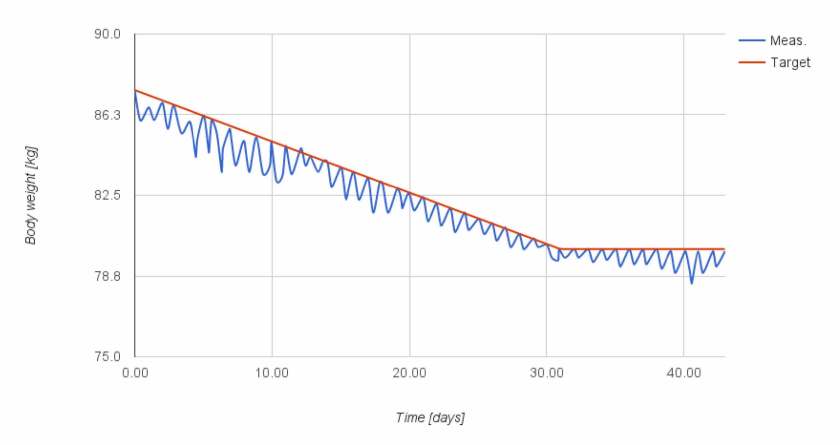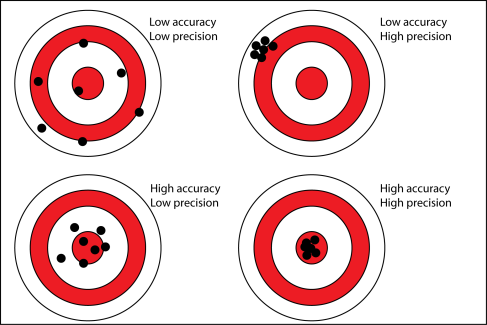This page discusses the method for feedback weight control that I have described in my IFAC Blog article. The article was based on personal experience I gained by applying results from my area of research, control theory, to my personal challenge of getting rid of a slight overweight.
My article has received substantial attention, especially in Danish media. I feel flattered, but I would like to emphasize that at the very best, I have rediscovered a few pieces of knowledge that had all been known already for a long time. However, if I have contributed by disseminating this knowledge to a wider audience to the benefit of some, that would make me both pleased and honored.
I have received a huge number of questions about the method. Below, I will try to describe the method step-by-step and to answer some of the many questions.
Here is an overview of the method (for clarity, the kg / lbs conversion is deliberately inaccurate):
- Start by recording your body weight an evening after the last meal of the day. This weight is your initial point, e.g. 80.0 kg (176 lbs).
- Select an end target and a number of days to reach that target, e.g. 76.0 kg (168 lbs) and 30 days.
- Compute the corresponding daily weight loss, e.g. 4 kg = 4000 g in 40 days corresponds to 100 g per day (176-168 = 8 lbs in 40 days corresponds to 0.2 lbs per day).
- Compute for every day the predefined daily target after your weight loss, e.g.
- 1st evening: 80.0 kg / 176.0 lbs (initial measurement)
- 2nd evening: 79.9 kg / 175.8 lbs (100 g / 0.2 Lbs less)
- 3rd evening: 79.8 kg / 175.6 lbs
- 4th evening: 79.7 kg / 175.4 lbs
- …
- 40th evening: 76.1 kg / 168.2 lbs
- 41st evening: 76.0 kg / 168.0 lbs (end target)
- Now, the method commences! You have to measure your weight in the morning, e.g. 78.8 kg / 173.4 lbs in the morning of Day 2. That means that you can eat at least 79.9-78.8 = 1.1 kg (175.8-173.4 = 2.4 lbs) during Day 2.
- You now have to weigh your meals. As an example, you can plan to eat 1.1 kg food as 300 g breakfast, 300 g lunch and 500 g dinner (2.4 lbs = 0.7 + 0.7 + 1.0 lbs).
- During the day, however, you will lose more weight. Therefore, you have to measure your weight again prior to the last meal of the day. Assuming that your weight at that time is 79.2 kg / 174.3 lbs at Day 2. That means that you have to eat exactly 79.9-79.2 kg = 700 g (175.8-174.3 lbs = 1.5 lbs) for the last meal of the day, instead of the 500 g / 1.0 lbs estimated in the previous step. Right after this meal your weight have to equal the daily target of the day precisely, e.g. 79.9 kg / 175.8 lbs on Day 2.
- The following days you have to do exactly the same:
- Measure your weight in the morning
- Subtract the morning weight from the day’s target
- Plan the meals of the day based on the difference
- Measure yourself again in the evening just before the last meal
- Subtract the evening weight from the day’s target
- Eat exactly this difference during the last meal
- Now, you should have reached the daily target precisely!
- After the scheduled number of days, your weight should be exactly equal to your end target weight! It is important to reach your daily target each day, i.e. to be neither below nor above the predefined daily target.
- When you have reached your end target, the daily target stays constant, e.g. 76.0 kg / 168.0 lbs. The method proceeds exactly like before, but now with this constant daily target.

References:
Several readers have alerted me that a method, which in several ways is similar to mine, has been published in:
John Walker: The Hackers’s Diet: How to lose weight and hair through stress and poor nutrition, 1991.
This is a very well-written reference, which I would strongly recommend!
ScienceNordic had a popular science article about the method, Scientist: lose weight effectively with a simple math-based diet, on Jan 12, 2017.
A great description of the physics behind weight loss can be found in this TEDx lecture: The mathematics of weight loss | Ruben Meerman | TEDxQUT.
iPhone app:
An app for iPhone is available at Apple’s App Store:
Apps for other platforms are currently not available, but the users of the Facebook groups (see below) have developed some very useful spreadsheets that serve the same purpose.
Facebook group(s):
Users are discussing the method on several Facebook groups in Danish. Recently an English language group has also been created:
The Math Diet by Jakob Stoustrup
What about liquids?
I get a lot of questions concerning liquids. In principle, all liquids have to be weighed in, and that is what I did during my pilot experiment. In practice, however, this is not crucial, as you quickly secrete roughly the same amount of liquid as you drink. In fact, you secrete a little more liquid than you drink, when you are losing weight. In short, you do not necessarily have to include liquids in the meal weights, as long as you make sure to hit your daily target spot on every day.
What about coke?
Liquid consumption is in principle the same e.g. for water and for coke. If you drink 2l coke a day, you also secrete approx. 2l of water, so that balances out. A 12 oz coke contains approximately 39 g of sugar, so in principle that should be included, but in terms of weight that is really a marginal number. However, if you drink 2l of cola today, your weight loss tonight is going to be considerable lower than it would have otherwise been, so tomorrow, you can eat much less than if you had drunk 2l of water.
Surely it matters whether you eat fatty or lean food?
First, let me emphasize that it is always recommendable to eat healthy – also when following my method. If you eat energy rich food, the body extracts less from its reserves and more in direct conversion, than if you eat lean food. That means that next morning, you will weigh less if you had lean food, and more if you had fatty food. Thus, with an energy rich diet you get a smaller ‘margin’ next day to your daily target, and can therefore eat considerably less. With my method, in principle you can eat whatever you like, but if you do not eat in a healthy way, on the long term you won’t get to eat a lot. This is actually motivating to eat in a healthy way. For the sake of science, I tried both during my pilot experiment. The days following an evening with lots of red meat + wine + snacks were quite tough to get through…
How accurate does my bathroom/kitchen scale need to be?
It is not highly important to have an accurate scale. Most bathroom scales have a resolution of +/- 100 g, and that works fine. On a given day this can of course give some variation in the amount you can eat, but that balances out in a few days. I had chosen a daily weight loss of 239 g a day. This loss can of course not be met accurately on a single day unless you have an unusually high resolution on your bathroom scale. I could, however, hit 2.4 kg in ten days, etc. The same applies to the kitchen scale. Potential measurement errors balances out in a couple of days.
For the nerds: in technical science we distinguish between accuracy and precision – please, see figure below. In this context, the important concept is precision. It doesn’t matter a lot that the scale doesn’t show the correct number, as long as it doesn’t vary too much from time to time – otherwise you get unpleasant variations in your amount of food.

Can you also gain weight with this method?
Most questions I have received regard weight loss. I have, however, also been asked whether this method can be used for body weight gain. The short answer is ‘yes’. If you substitute the daily weight loss with a desired weight gain, the method ought to work in exactly the same way. I don’t have, however, any empirical background for this and would love to hear from users who have tried to gain weight using this approach.
Can I take a break from this diet?
Of course. All you need to do is to set your daily weight loss to zero for however long you want. Your allowable daily intake will then immediately increase by the amount that you used to lose. However, you will probably see that in a few days that your body will react by increasing the metabolism, as you are no longer emptying its reserves. Thus, you can expect that your daily intake will automatically increase further.
You are strongly advised against taking a break without monitoring your weight. After a period of weight loss, your metabolism is likely to be at a minimum. This will stimulate overeating and your body will be gaining weight more rapidly than usual.
I get too little to eat/don’t like to weigh myself/don’t like to weigh my food/don’t like the math/just don’t like this diet. In short, I want to stop!
If you stop, please be aware that you risk a rebound. If you have been following the method for some time, your metabolism is likely at a low level. This will stimulate your brain to overeat and your body will be disposed for fast weight gain.
You are advised to monitor your weight in the period after stopping. The optimal approach is to follow the method for a little longer with a zero weight loss or even a small deliberate weight gain (to give you larger meals). For weight gain, please see see separate answer.
